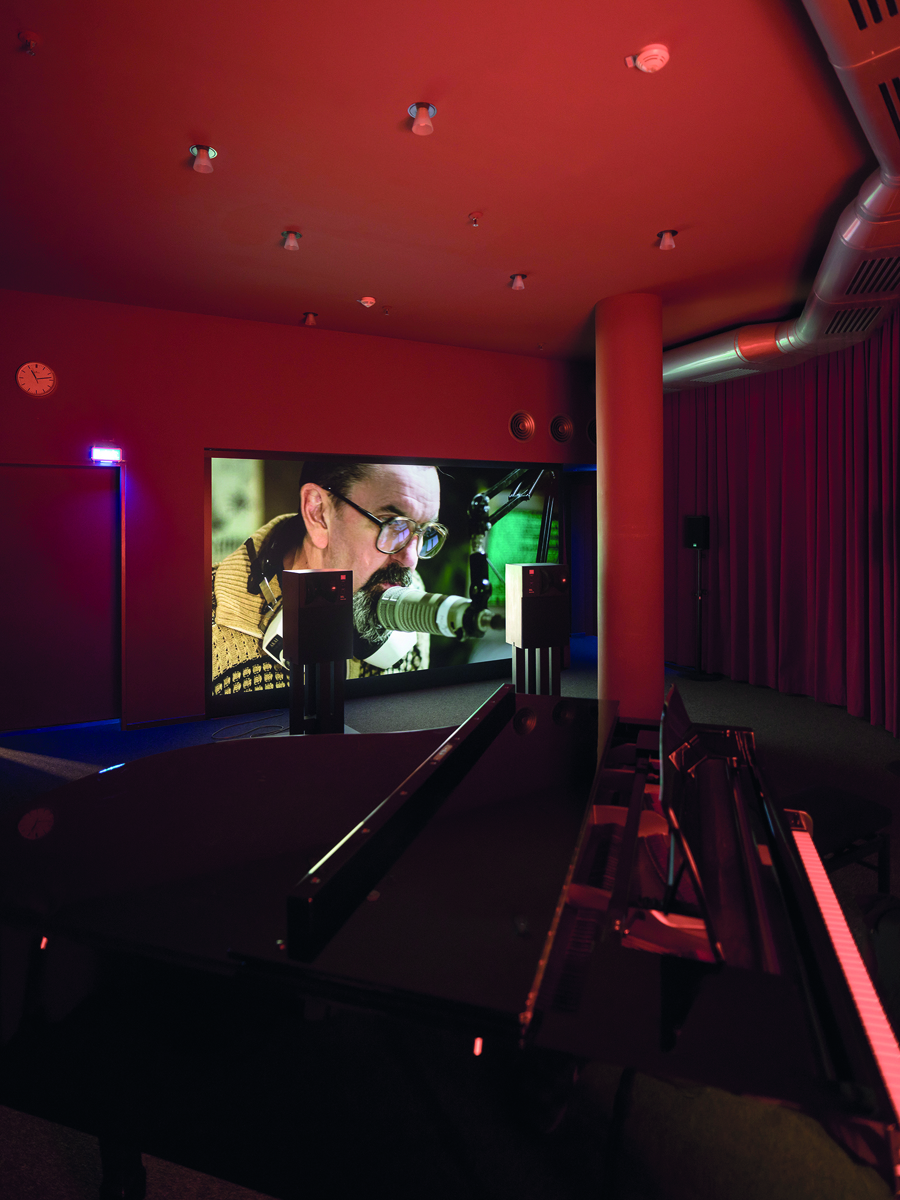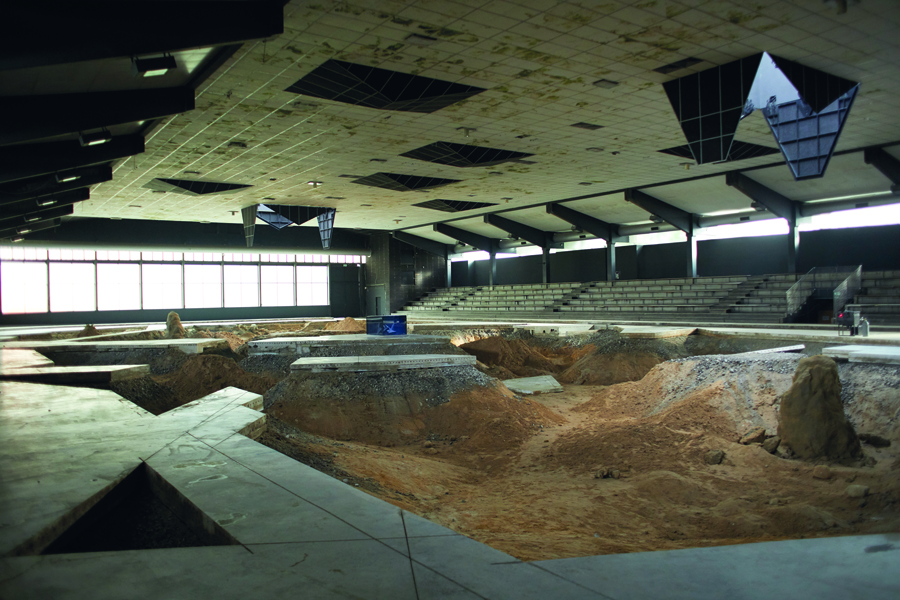Skulptur Projekte Münster
Various venues, Münster, Germany
Various venues, Münster, Germany

Initiated in 1977 by Klaus Bussmann and curated by Kasper König, Skulptur Projekte Münster (Sculpture Projects Münster) was originally intended as a one-off public art project in this small, western German city. It has since taken place every ten years and mostly occupies public areas in and around the city. If the exhibition’s model has, in the intervening time, become a far-reaching tradition, then the move to show only newly commissioned artworks has become increasingly rare – largely absent, for example, at this year’s other large-scale summer exhibition in Germany, documenta 14, which opened only days earlier.
The fifth iteration of the event, directed by König and curated by Britta Peters and Marianne Wagner, includes 35 new commissions under no umbrella ‘theme’. The exhibition’s format has changed little, even after developments in what we understand as ‘public space’ and the ascendance of socially grounded artistic practices in recent years. Yet the scale and ambition of the projects have dramatically evolved, reflecting with each edition ever more expanded ideas of sculpture, public space and site specificity.
This year, a collaboration with the Skulpturenmuseum Glaskasten Marl, entitled The Hot Wire, serves to connect Sculpture Projects with the nearby city of Marl, which has its own distinct history of postwar public sculpture and shows works by Thomas Schütte and Joëlle Tuerlinckx. Another high point afforded by the scale and relative infrequency of the exhibition is its engagement with its own history. At the LWL Museum for Art and Culture is Michael Asher’s Double Check, which occurred in 1977, 1987, 1997 and 2007. Asher placed a caravan at various sites in the city and moved it around on a weekly basis, repeating the act for each iteration of the exhibition. With the caravan seldom present in public space, the work now appears as a mediation of the event’s own past, via archival material and photographs.

This year a number of works broadened the notion of sculpture in public space to encompass performance, for example in works by Xavier Le Roy (collaborating with Scarlet Yu), Alexandra Pirici and Gintersdorfer/Klaßen. Similarly ephemeral is a sound intervention by Cerith Wyn Evans, A Modified Threshold … (for Münster) Existing Church Bells Made to Ring at a (Slightly) Higher Pitch (all works 2017), which takes place in St Stephanus Church. In this brutalist building, part of Münster’s urban development in the 1960s, Wyn Evans installed an industrial air-cooling system in the church tower to lower the bells’ temperature, augmenting their pitch: an enormous technical undertaking that remains invisible, and nearly inaudible, to the audience.
‘Site specificity’ itself was commented upon in Nairy Baghramian’s Beliebte Stellen (Privileged Points): two tubular bronze sculptures, each made of several individual parts that will not be welded together until the end of the exhibition, and then only if the work is purchased. The points of ‘privilege’ in question are the front and back courtyards of the baroque Erbdrostenhof palace, the same spots selected by Richard Serra in 1987 and Andreas Siekmann in 2007. Lying incomplete and inert, Baghramian’s sculptures free – which will presumably be moved upon purchase – free themselves from ‘site’ while commenting on patterns of male domination in the history of sculpture.
At other places, the relationship between artwork and place is more inscrutable. Presented in the basement of the City Library Münster, Gerard Byrne’s 20-minute film In Our Time takes place in a fictional radio control booth. A DJ reads the news, presents advertisements and plays music. The script is a mélange of various radio transcriptions of shows from the early 1970s. The film engagingly transports the viewer back to a different era and unveils what is usually invisible to the radio listener, while resonating with more recent phenomena such as a 24/7 news cycle, ‘fake news’ and a global broadcast culture.

Ei Arakawa’s Harsh Citation, Harsh Pastoral, Harsh Münster engages with its location in a clearer way. Seven LED screens occupy a large field near Lake Aasee and turn better- and lesser-known paintings into seemingly free-standing advertisements. Each screen shows a digital copy of a painting by the artist’s friends, former teachers or artistic influences, from Gustave Courbet to Jutta Koether, Joan Mitchell, Amy Sillman and Reena Spaulings. Courbet’s La Rencontre (The Meeting, 1854) sets the tone, depicting an artist strolling through a field. Each screen plays a soundtrack, singing an interpretive song that tells the visitor what it is ‘about’. In this pastoral setting, Arakawa critiques both the normative presentation of paintings as static objects while toying with the discursive embellishment of ‘painting’ as performance.
Conceptually overloaded but visually arresting is Pierre Huyghe’s spectacular After ALife Ahead, which transforms a former ice skating rink that is about to be demolished into an almost moonlike landscape, exposing the various layers of earth beneath the building, from clay to sand and gravel, all inhabited by biological life such as algae, bacteria and beehives. The roof opens and closes as determined by an algorithm based on the growth of incubated cancer cells, their rate of reproduction in turn synched with the vitality of the space (the movement of bees, CO2 and bacteria levels). A symbiosis of architecture, biological phenomena and symbolic landscape, the intervention suggests location and dislocation at once.
A similar movement away from Münster is enacted by Mika Rottenberg’s film and installation Cosmic Generator. Set in a surreal readymade environment – a now-defunct store that previously specialized in selling Asian products – it operates between fact and fiction to speak about commerce in a globalized world. The film revolves around a tunnel system between Mexicali and Calexico that is used for illegal trade and can only be entered on the Mexican side via stores in Mexicali’s Chinatown. Footage of the tunnels is interspersed with images of a gigantic Chinese market selling products like those usually found in 99-cent stores in the US. The project points at globalization, illegal trade, exploitation of workers and that all accompany the invisible transfer of consumer goods.

Michael Smith’s humorous Not Quite Under_Ground is a fully functional tattoo parlour catering especially to those 65 and older, who get senior-citizen discounts on tattoos – a now-mainstream, once-countercultural gesture that jars with the establishment’s target demographic. Designs by artists (many participating in the event) become permanent souvenirs for the visitor-participants – instances of self-expression that unite the outside of the human body with the performance of interior aesthetic sensibility.
Also taking us fully back to Münster is Bye Deutschland! Eine Lebensmelodie by Benjamin de Burca and Bárbara Wagner. The 20-minute video projection in the Elephant Lounge (a typically German nightclub somewhere between discotheque and adult entertainment site) investigates the Schlager genre: tacky, escapist music that revolves around romance, broken relationships and the everyday problems of normal people. Jeremy Deller’s project, too, is grounded in the life of everyday Germans. Deller was intrigued by Münster’s Schrebergärten: tiny parcels of urban land designated in the mid-19th century for workers to cultivate as gardens in order to bring nature to industrialized city life. In 2007, contacted about 50 of the small organizations that run the garden allotments, asking them to keep diaries of their activities over a period of ten years, which he now presents in 22 volumes in one of the gardens. He also planted a number of dove trees in 2007, which have blossomed after ten years.
Münster is a surreal backdrop for a contemporary art exhibition, given its faux-historical façades and visible affluence. Absent are works commenting on global challenges such as climate change, environmental destruction, religious conflicts and economic inequalities. Yet Sculpture Projects, the best of this summer’s large-scale exhibitions, is outstanding due to how artists were given free rein, and funding, to make new work at a large scale without many restrictions. This has become all too rare within current exhibition-making. Whether the next iteration can sustain this high level of artistic achievement is something we’ll have to wait another decade to find out.
Main image: Nicole Eiseman, Sketch for a Fountain, 2017, Skulptur Projekte 2017, bronze, gips, wasserbecken. Courtesy: Skulptur Projekte Münster





















